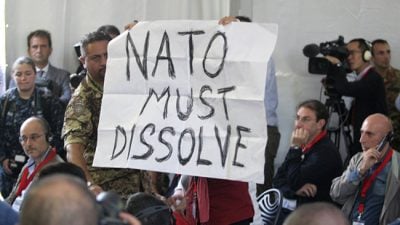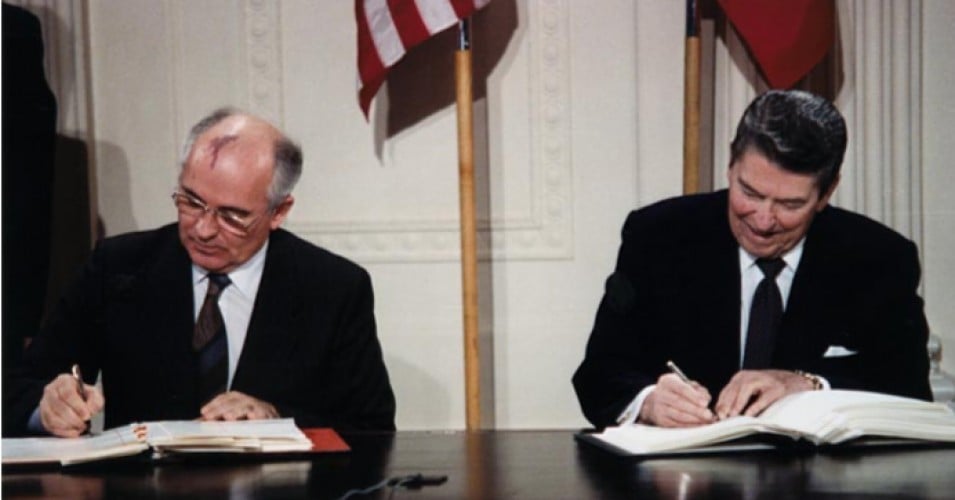The Renewal of NATO in the Post-Cold War Era
The 70 Years of NATO: From War to War

The Following text is Section 2 of
The 70 Years of NATO: From War to War,
by the Italian Committee No War No NATO
*
Documentation presented at the International Conference on the 70th Anniversary of NATO, Florence, April 7, 2019
In the course of the next two weeks, Global Research will publish the 16 sections of this important document, which will also be available as an E-book.
*
Contents
1. NATO is born from the Bomb
2. In the post-Cold War, NATO is renewed
3. NATO demolishes the Yugoslav state
4. NATO expands eastward to Russia
5. US and NATO attack Afghanistan and Iraq
6. NATO demolishes the Libyan state
7. The US/NATO war to demolish Syria
8. Israel and the Emirates in NATO
9. The US/NATO orchestration of the coup in Ukraine
10. US/NATO escalation in Europe
11. Italy, the aircraft carrier on the war front
12. US and NATO reject the UN treaty and deploy new nuclear weapons in Europe
13. US and NATO sink the INF Treaty
14. The Western American Empire plays the war card
15. The US/NATO planetary war system
16. Exiting the war system of NATO
***
1. In the second half of the 1980s, the climate of the Cold War began to change. The first sign of thawing was the Treaty on Intermediate Nuclear Forces (INF), signed in Washington on December 8, 1987, by Presidents Reagan and Gorbachev. According to the INF, the United States and the Soviet Union were to undertake to eliminate all missiles of this category, including the Pershing II and the cruise missiles deployed by the US in European NATO countries and the SS-20 deployed by the USSR in their territory. By May 1991, a total of 2,692 missiles in this category were removed.
Former Soviet leader Mikhail Gorbachev and U.S. President Ronald Reagan signed a landmark nuclear arms control treaty in 1987. (Photo: White House Photographic Office/National Archives and Records Administration)
2. This important result was essentially due to the “disarmament offensive” launched by the Soviet Union under Gorbachev. On January 15, 1986, it proposed not only to eliminate Soviet and US intermediate range missiles, but to implement an overall program to eliminate nuclear weapons by 2000. In Washington, they knew that Gorbachev really wanted the complete elimination of these weapons, but they also knew that in the Warsaw Pact and in the Soviet Union itself a process of disintegration was taking place, a process that the United States and their allies favored by all possible means.
3. After the fall of the Berlin Wall in November 1989, the Warsaw Pact dissolved in July 1991. The six central and eastern European countries that were part of it were no longer allies of the USSR. In December 1991, the Soviet Union itself dissolved. Fifteen states were formed in place of a single state. The disappearance of the USSR and its block of alliances created an entirely new geopolitical situation in the European and Central Asian regions. At the same time, the disintegration of the USSR and the deep political and economic crisis affecting the Russian Federation marked the end of the only superpower able to rival that of the United States.
4. The United States immediately took advantage of the “détente” in Europe to concentrate their forces in the strategic area of the Persian Gulf, where, with a clever maneuver, they prepared the conditions to unleash what the Pentagon called “the first post-Cold War conflict, a determining event in the global leadership of the United States”. On 17 January 1991, the US launched Operation Desert Storm against the Iraqi Army – “the most intense bombing campaign in history”. Over 43 days, the US and its allies (including the Italy) used 2,800 aircraft to drop about 250,000 bombs, including cluster bombs, which issued a total of over 10 million submunitions, while flying gunships, helicopters and tanks shot over a million depleted uranium projectiles. On 23rd February, the coalition troops, comprising over half a million soldiers, launched a ground offensive, which, after a hundred hours of carnage, ended on 28th February with a “temporary ceasefire” proclaimed by President Bush.
5. NATO, while not participating as such in the Gulf War, provided the backing of all its infrastructure to coalition forces. They took part in the bombings, along with the US, British, French, Italian, Greek, Spanish, Portuguese, Belgian, Dutch, Danish, Norwegian and Canadian air forces and naval forces, while British and French forces joined US forces in the land-based offensive.
6. A new strategy, published by the White House in August 1991 called the “National Security Strategy of the United States”, was officially announced six months after the end of the Gulf War. The central concept was that “the United States remains the only state with a force, a scale and influence in every dimension – political, economic and military – truly global: there is no substitute for American leadership. Our responsibility, even in the new era, is of cardinal and inescapable importance.
7. A Pentagon document, drawn up in February 1992, clarified that “our primary objective is to prevent the re-emergence of a new rival, either on the territory of the former Soviet Union or elsewhere, which poses a threat in the order of the one previously posed by the Soviet Union. The new strategy requires that we work to prevent any hostile power from dominating a region whose resources would be sufficient, if tightly controlled, to generate global power. This strategy will be adopted in all ‘critical US security regions, which include Europe, East Asia, the Middle East, South-West Asia and the territory of the former Soviet Union.’ We also have important interests in Latin America, Oceania and Sub-Saharan Africa”.
8. “A key issue – the White House underlines in the National Security Strategy 1991– is how the role of America as the leader of the Alliance, and indeed our own alliances, will be influenced, especially in Europe, by the reduction of the Soviet threat. The differences between the allies will probably become more evident as the traditional security concern that brought them together at the beginning.” In other words, the European allies could make divergent choices from those of the United States, questioning the US leadership or even leaving NATO, now outdated by the new geopolitical situation. It was, therefore, of the utmost urgency for the United States to redefine not only the strategy but the role of NATO itself.
9. On November 7, 1991, the heads of state and governments of the 16 NATO countries, meeting in Rome in the Atlantic Council, launched “The new strategic concept of the Alliance”. Although on the one hand “the monolithic, massive threat that has been the main concern of the Alliance in its first forty years has disappeared,” – the document states – “the risks that remain for the Alliance’s security are multifaceted and multidirectional in nature. The military dimension of our Alliance therefore remains an essential factor, but the new fact is that it will be more than ever at the service of a broad concept of security “. In this way, the Atlantic Alliance fundamentally redefined its role along the lines drawn up by the USA.
*
Sections 3-16 of the 70 Years of NATO, From War to War, forthcoming on Global Research
This text was translated from the Italian document which was distributed to participants at the April 7 Conference. It does not include sources and references.
Note to readers: please click the share buttons below. Forward this article to your email lists. Crosspost on your blog site, internet forums. etc.


